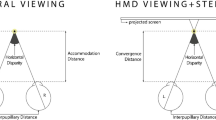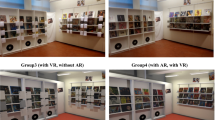Abstract
This paper preconizes the use of interactive environments as an accessible and inexpensive solution that allows supporting the recovery process of people receiving occupational therapy rehabilitation. A method for designing interactive environments is proposed in order to identify the interaction capabilities. These capabilities should be taken into account when producing interactive environments for users with different levels of ability/disability. In addition, the developed interactive environments offer rehabilitation support to diverse needs of users with physical disabilities. It is possible to capitalize the good practices established in occupational therapy, allowing the generation of useful information for therapists/health experts. Finally, a case study presents the performance of interactive environments for people receiving occupational therapy for hand rehabilitation at DIF, Aguascalientes in Mexico.




















Similar content being viewed by others
References
World Health Organization, Disability and Health, Fact sheet N352, September 2013, (Retrieved August 2014). http://www.who.int: http://www.who.int/mediacentre/factsheets/fs352/es/
Ayuso, D.M.R.: Actividades de la vida diaria. Anales de psicología 23(2), 264–271 (2007)
Word Federation of Occupational Therapists, Definition of Occupational Therapy (Consultado 01 de octubre del 2015), 2010. http://www.wfot.org/AboutUs/AboutOccupationalTherapy/DefinitionofOccupationalTherapy.aspx
Jackson, J., et al.: Occupation in lifestyle redesign: the Well Elderly Study Occupational Therapy Program. Am. J. Occup. Ther. 52(5), 32636 (1998)
de la Salud, S.: Catálogo Maestro de Guías de Práctica Clínica (CMGPC), (Retrieved: March 2014). http://www.cenetec.salud.gob.mx, http://www.cenetec.salud.gob.mx/contenidos/gpc/catalogoMaestroGPC.html (2015)
Diaper, D.: The discipline of human-computer interaction en Interacting with computers, vol. 1, p. 1. (1989)
Lorés, J., et al.: La interacción Persona-Ordenador (J. Lorś, Ed.) AIPO, Lleida (2002)
Kim, K., Kang, J., Lee, Y., Moon, C., Choi, H., Mun, C., Osman, N., Abas, W., Wahab, A., Ting, H.-N. (eds.) The Development of Muscle Training System Using the Electromyogram and Interactive Game for Physical Rehabilitation 5th Kuala Lumpur International Conference on Biomedical Engineering 2011, vol. 35, pp. 801–804. Springer, Berlin (2011)
Yeh, S.C., Lee, S.H., Fan, Y.C.: The development of interactive shoulder joint rehabilitation system using virtual reality in association with motion-sensing technology. In: Huang, Y.M., Chao, H.C., Deng, D.J., Park, J. (eds.) Advanced technologies, embedded and multimedia for human-centric computing, Lecture Notes in Electrical Engineering, vol. 260, Springer, Dordrecht (2014)
Shin, J.H., Ryu, H., Jang, S.H.: A task-specific interactive game-based virtual reality rehabilitation system for patients with stroke: a usability test and two clinical experiments. J. NeuroEng. Rehabil. 11(1), 1 (2014)
Miyoshi, H., Kimura, Y., Tamura, T., Sekine, M., Okabe, I., Hara, K., Lackovi, I., Vasic, D. (eds.) Smart living—home rehabilitation training system using an interactive television. In: 6th European Conference of the International Federation for Medical and Biological Engineering, vol. 45, pp. 661–665. Springer (2015)
Chang, Y.J., Chen, S.F., Huang, J.D.: A kinect-based system for physical rehabilitation: a pilot study for young adults with motor disabilities. Res. Dev. Disabil. 32(6), 2566–2570 (2011)
Broeren, J., Rydmark, M., Sunnerhagen, K.S.: Virtual reality and haptics as a training device for movement rehabilitation after stroke: a single-case study. Arch. Phys. Med. Rehabil. 85(8), 1247–1250 (2004)
Lohse, K.R., Hilderman, C.G., Cheung, K.L., Tatla, S., Van der Loos, H.M.: Virtual reality therapy for adults post-stroke: a systematic review and meta-analysis exploring virtual environments and commercial games in therapy. PLoS ONE 9(3), e93318 (2014)
Saposnik, G., Teasell, R., Mamdani, M., Hall, J., McIlroy, W., Cheung, D., Stroke Outcome Research Canada (SORCan) Working Group: Effectiveness of virtual reality using Wii gaming technology in stroke rehabilitation a pilot randomized clinical trial and proof of principle. Stroke 41(7), 1477–1484 (2010)
Prange, G.B., Kottink, A.I., Buurke, J.H., Eckhardt, M.M., van Keulen-Rouweler, B.J., Ribbers, G.M., Rietman, J.S.: The effect of arm support combined with rehabilitation games on upper-extremity function in subacute stroke a randomized controlled trial. Neurorehabil. Neural Repair 29(2), 174–182 (2015)
Alankus, G., Lazar, A., May, M., Kelleher, C.: Towards customizable games for stroke rehabilitation. In: Proceedings of the SIGCHI Conference on Human Factors in Computing Systems, pp. 2113–2122. ACM (2010)
Carabeo, C.G.G., Dalida, C.M.M., Padilla, E.M.Z., Rodrigo, M.M.T.: Stroke patient rehabilitation a pilot study of an android-based game. Simul. Gaming 45(2), 151–166 (2014)
Martínez, M.M., Ríos Rincón, A.: La tecnología en rehabilitación: una aproximación conceptual. Revista Ciencias de la Salud, 4(2), 98–108. Retrieved August 10, 2016. http://www.scielo.org.co/ (2006)
Occupational Therapists College: Code of ethics and professional conduct for occupational therapists. COT, London (1995)
American Occupational Therapy Association: Enforcement procedures for the occupational therapy code of ethics and ethics standards. Am. J. Occup. Ther. 68(Suppl. 3), S3S15 (2014). doi:10.5014/ajot.2014.686S02
Rigby, M.: Applying emergent ubiquitous technologies in health: the need to respond to new challenges of opportunity, expectation, and responsibility. Int. J. Med. Inform. 76, S349–S352 (2007)
Abras, C., Maloney-Krichmar, D., Preece, J.: User-centered design. In: Bainbridge, W. (ed.) Encyclopedia of Human–Computer Interaction, vol. 37, no. (4), pp. 445–456. Sage Publications, Thousand Oaks (2004)
Pleuss, A., Hussmann, H.: Model-driven development of interactive multimedia applications with MML. In: Hussmann, H., Meixner, G., Zuehlke, D. (eds.) Model-driven development of advanced user interfaces, pp. 199–218. Springer, Berlin (2011)
Clements, P., Northrop, L.: Software Product Lines: Practices and Patterns. Addison-Wesley, Boston (2001)
Arteaga Muñoz, J., Cardona Reyes, H., Acosta Escalante, F.: Hand rehabilitation patterns for designing interactive environments. IEEE Latin Am. Trans. 14(2), 922–929 (2016). doi:10.1109/TLA.2016.7437241
Paternò, F.: Concur Task Trees: an Engineered Notation for Task Models, The Handbook of Task Analysis for Human–Computer Interaction, pp. 483–503 (2003)
Jung, B., Lenk, M., Vitzthum, A., Sachsen, B.: Model-driven multi-platform development of 3d applications with round-trip engineering. In: Kowalewski, S., Rumpe, B. (eds.) Proceedings of software engineering, GI-Edition Lecture Notes in Informatics (LNI), vol.P-213, pp. 287-300. (2013)
Munstermann, M., Stevens, T., Luther, W.: A novel human autonomy assessment system. Sensors 12(6), 7828–7854 (2012)
Sistema para el Desarrollo Integral de la Familia Aguascalientes,DIF, (Citada: 10 octubre 2014). http://www.aguascalientes.gob.mx/dif/
Valverde, M.E., Serrano, M.P.: Terapia de neuro desarrollo: concepto Bobath. Plasticidad y restauración neurológica. Nuevos horizontes en la restauración neurológica, vol 2, N 2, Julio-Diciembre 2003. Edigraphic. com (2003).
Colgan, A.: Medical and assistive technologies being transformed with LeapMotion (2015). http://blog.leapmotion.com, http://blog.leapmotion.com/5-medical-and-assistive-technologies-being-transformed-with-leap-motion-tech/
Hellín, T.: Ejercicios de mano y muñeca, (Retrieved October 2014). http://traumatologiahellin.wordpress.com/ejercicios/ejercicios-de-mano-y-muneca/
Mathiowetz, V., Weber, K., Volland, G., Kashman, N.: Reliability and validity of grip and pinch strength evaluations. J. Hand Surg. 9(2), 222–226 (1984)
Hudak, P.L., Amadio, P.C., Bombardier, C., Beaton, D., Cole, D., Davis, A., Marx, R.G.: Development of an upper extremity outcome measure: the DASH (disabilities of the arm, shoulder, and hand). Am. J. Ind. Med. 29(6), 602–608 (1996)
Turner-Bowker, D.M., DeRosa, M.A., John E.W.: SF-36® Health Survey. In: Boslaugh (ed.) Encyclopedia of Epidemiology, vol. 2, Sage Publications, Thousand Oaks (2008). Available at: http://works.bepress.com/john_ware/87/
de la Salud, S.: Cuestionario de la Salud. http://www.dgplades.salud.gob.mx, http://www.dgplades.salud.gob.mx/Contenidos/Documentos/CuestionarioSalud (2009)
Alonso, J., Prieto, L., Antó, J.M.: La versión espanõla del SF-36 health survey (Cuestionario de Salud SF-36): un instrumento para la medida de los resultados clínicos. Med. Clin. (Barc) 104, 771–776 (1995)
Lewis, J.R.: IBM computer usability satisfaction questionnaires: psychometric evaluation and instructions for use. Int. J. Hum. Comput. Interact. 7(1), 57–78 (1995)
Acknowledgements
The authors appreciate the financial support given by CONACYT for the present research and thank to authorities from Physical Therapy Unit, DIF Aguascalientes for their help in conducting the case study presented in this paper.
Author information
Authors and Affiliations
Corresponding author
Rights and permissions
About this article
Cite this article
Reyes, H.C., Arteaga, J.M. Occupational therapy for people with physical disability using interactive environments. Univ Access Inf Soc 17, 67–81 (2018). https://doi.org/10.1007/s10209-016-0519-3
Published:
Issue Date:
DOI: https://doi.org/10.1007/s10209-016-0519-3




